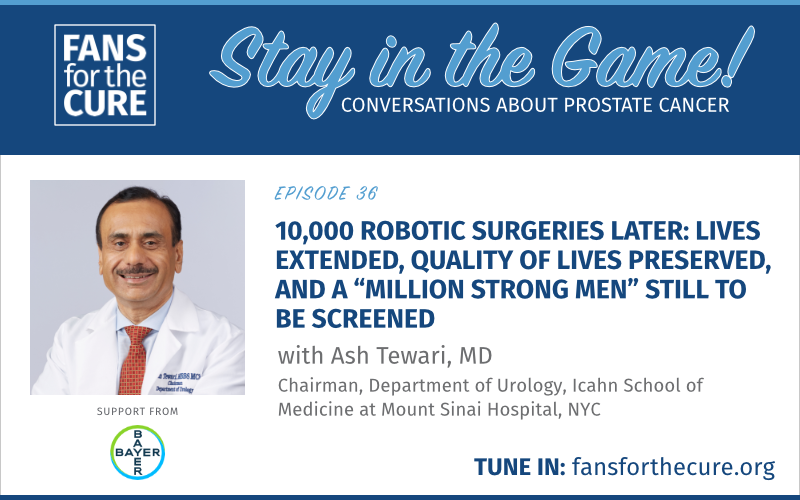As Fans for the Cure pivots to more online offerings to support men during the coronavirus pandemic, we launched a new FAQ section on our website. Over time, this FAQ will provide answers, informations, links, and sign posts to more in-depth guidance in response to topics raised in our online support groups and at health events in communities we serve.
Prostate Cancer FAQ
Several friends and work colleagues have achieved good results following treatment for prostate cancer. The problem is that there is no consensus on the best treatment plan. It seems that there are three or four ways to go. How do I choose the treatment route that is best for me?
Friends and acquaintances who have “been there” can be valuable resources for names of doctors, as well as for questions to bring to those doctors. They are also good for high-level advice about the treatment decision process, often undertaken with loved ones and an interdisciplinary team of physicians.
One must keep in mind, however, that everyone is different and so is that person’s disease. Cancer staging, Gleason score, PSA velocity, the volume and location of the tumor – along with a person’s age and overall health – are just some of the variables that shape a man’s personal treatment decision.
I recently heard the term “doubling time” about PSA progression following my radical prostatectomy. What does this mean?
The short answer that the slower the rise in PSA over time (known as the velocity), the slower the growth of any cancer cells. Should the time it takes for a man’s PSA to double (PSADT, or prostate-specific antigen doubling time) be a year or more, then any tumor can be considered slow growing. Should the doubling time be short (3-4 months, for example), then a form of targeted treatment would likely replace watchful waiting.
Dr. Lloyd Minsky, a Urologist with Northwell Health, introduced PSADT as a metric at one of our men’s support groups as several post-treatment men voiced concerns about rising PSA test results that were listed by labs or hospitals as “normal” or “in range.”
I have prostate cancer, and I have sons. Are they in a high-risk group for prostate cancer? At what age should they begin screenings?
Yes, male relatives – brothers, sons, cousins, nephews –are more at risk for prostate cancer. Your sons’ specific risk depends on your age at diagnosis. The closer you were to age 72 at diagnosis, the more your sons’ chances of being diagnosed with prostate cancer level out to that of the general male population.
Our doctors have recommended that for those men with a family history of prostate cancer, conversations with their primary-care doctors or urologists about annual PSA screenings should take place starting at age 40.
What is meant by a five-year relative survival rate?
It is an estimate of how many people with the same type and same stage of cancer will be alive after a specific period, usually five years, compared with the general population at large over that time.
We often hear people invoke the terms “survival rate” and “relative survival rate” interchangeably.
They are not the same thing.
Prostate Cancer Survival Rate – the percentage of men diagnosed with prostate cancer who will survive for five years.
Prostate Cancer Relative Survival Rate – compares the five-year death rate of men with prostate cancer to the death rate of men over the same period who do not have prostate cancer. A specific age range is often applied in the fine print to a relative survival rate (for prostate cancer usually over 50).
Example: should 97 men of 100 make it to five years, that is a survival rate of 97%. Should the same 97 men (100 minus 3) be compared to another group of 100 men that experienced or were expected to experience three non-prostate cancer deaths, then the prostate cancer group had a relative survival rate of 100 percent.
When consulting the American Cancer Society’s statistics, it is best not to ignore the footnotes about survival rates, specifically:
- These rates apply to the staging done when the cancer was first diagnosed. Recurrences are not part survival rates measured by SEER tracking.
- While the SEER system tracks cancer based on how far it has spread (localized, regional, distant), it does not take in factors like a man’s overall health, his age, and results of PSA, 4Kscore, or other advanced blood testing. In short, your mileage may vary.
- Since the initial diagnoses that determine current survival rates were made more than five years ago, these rates can be expected to be higher for recent diagnoses. This is attributable to technological advancements and medical breakthroughs that have improved both diagnostics and treatment plans.
The American Cancer Society also provides a good example of a blended survival rate. We have all heard versions of “The relative survival rate of prostate cancer is 98%.” But here are specific numbers based on how SEER tracks and stages the disease:
Prostate Cancer: Five-Year Relative Survival Rates – SEER, 2010 – 2016
Localized – cancer confined to prostate — Nearly 100 percent.
Regional – cancer has moved to outside structures or lymph nodes – nearly 100 percent.
Distant – aggressive form of cancer that has spread to organs or to bones – about 30 percent.
Note: the distant cases do not move the survivability numbers significantly because the vast majority of prostate cancer cases in the U.S. (well over 90 percent) are non-lethal and highly treatable forms of the disease.
How likely is it that prostate cancer will spread without treatment of any kind?
Prostate cancer oncologists rely on several factors in estimating how quickly a particular case of prostate cancer will grow and/or spread. These factors are the clinical stage of the cancer, the results of an examination of the cancer cells (Gleason score), the PSA level and comparisons to previous tests, and, increasingly, the results of reflex testing (e.g. the 4Kscore). Evaluated as a group, these factors are used by oncologists to predict the risk of progression of a man’s individual case of prostate cancer progression.
Are “active surveillance” and “watchful waiting” the same?
We often hear the terms “active surveillance” and “watchful waiting” used interchangeably as recommended initial treatment strategies for low-risk and localized cases of prostate cancer. But are they the same thing?
The short answer is no.
As she shared on the Stay in the Game podcast, Dr. Stacy Loeb emphasized that active surveillance is active. While radiation therapies or prostatectomy surgery are not undertaken upon diagnosis in these patients, more frequent testing and monitoring are – including PSA tests, reflex texts (e.g. 4Kscore), MRIs, digital rectal exams, and biopsies. The goal is to appropriately address – and not overtreat – low-risk cases, while closely monitoring any changes to the velocity of the disease.
Watchful waiting refers to an approach taken with men who, for several reasons and in consultation with their physicians, might not wish to deal with the side effects and discomfort associated with radiation, surgery, or frequent testing.
Age: A man and his doctor might conclude that due to age and the specifics of his case, the odds overwhelmingly favor that man dying with prostate cancer and not because of it.
Age and Quality of Life: Men and their doctors conclude that the statistical life-expectancy gains of treatment simply do not justify the risk of treatment plan’s side effects or the ongoing pain and inconvenience of frequent testing.
In short, watchful waiting is active surveillance minus the frequent testing and possible pivot to radiation or surgery. Based on age and disease velocity, there are often transitions from active surveillance to the fewer doctor visits and less aggressive testing of watchful waiting.
Does an elevated PSA score mean that I have prostate cancer?
Prostate-specific antigen is a protein produced by both cancerous and non-cancerous tissue in the prostate. While small amounts of PSA are regularly present in the blood, the PSA test excels in detecting high levels of this protein in the blood which might indicate cancer. But high PSA levels might also indicate an enlarged (BPH) or inflamed prostate (prostatitis), or recent sexual activity.
The PSA test is not perfect, however. One of its limitations is that it has produced misleading results – both false positives and false negatives. Men with elevated PSA levels have been found to be cancer-free with further testing, and men with PSA values within the “acceptable” range have been diagnosed with prostate cancer.
We recommend having open and honest conversations with your doctor about the risks and limitations of the PSA testing, as well as a preliminary plan of action based on both positive and negative results.
When should a man be tested for prostate cancer?
Beginning at age 40, men should begin a conversation with their doctors about the benefits and limitations of prostate cancer screening tests, particularly the PSA (prostate-specific antigen in one’s blood).
Should you choose prostate cancer screenings, you should get a PSA test somewhere between the ages of 45-50. If you are African American or have a family history (father, uncles, brother, son), you should strongly consider getting tested (PSA, optional digital rectal exam) at or before age 45.
We recommend regular screenings between the ages of 50-75 at intervals decided upon by men and their doctors, based on test results and monitoring year-to-year increases in ng/mL values.
Between the ages of 76-85, men should continue their dialogues with their GPs and urologists to decide on a testing regimen for those years. Most healthcare websites discourage PSA testing for men over the age of 85.
What are the most common signs of prostate cancer?
The main reason that screening for prostate cancer is so important is that the vast majority of the localized – and most curable – cases of prostate cancer have no symptoms. A decrease in the force of the urinary stream, difficulty starting urination, and frequent nighttime urination are more likely to be BPH, or benign prostatic hyperplasia.
Note: A diagnosis of BPH does not completely rule out prostate cancer. There have been cases where BPH occurred coincidentally with the prostate cancer.
About 10% of all diagnoses, however, indicate advanced-stage prostate cancer that has spread outside the prostate and the lymph system. These cases are likely to have symptoms similar to those of BPH, including blood in the urine, painful urination and a decreased urinary flow.
Additional information is available on the Signs and Symptoms of Prostate Cancer page.
Ask Your Question
If you have a question about prostate cancer that you would like us to answer, we invite to you submit it to us via the form on our Ask Us a Question page.


